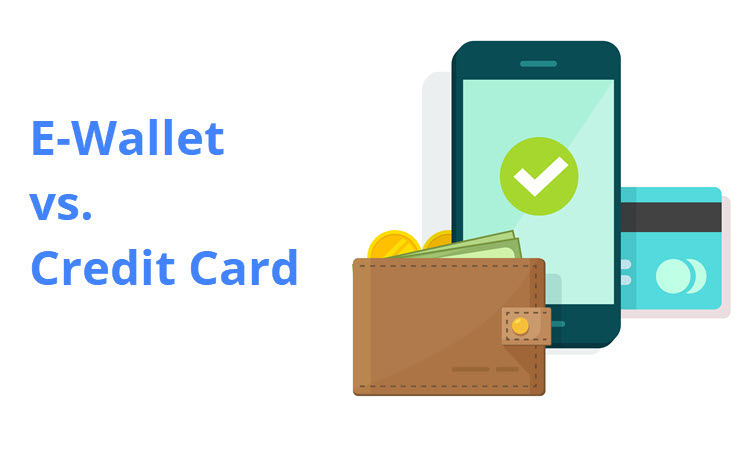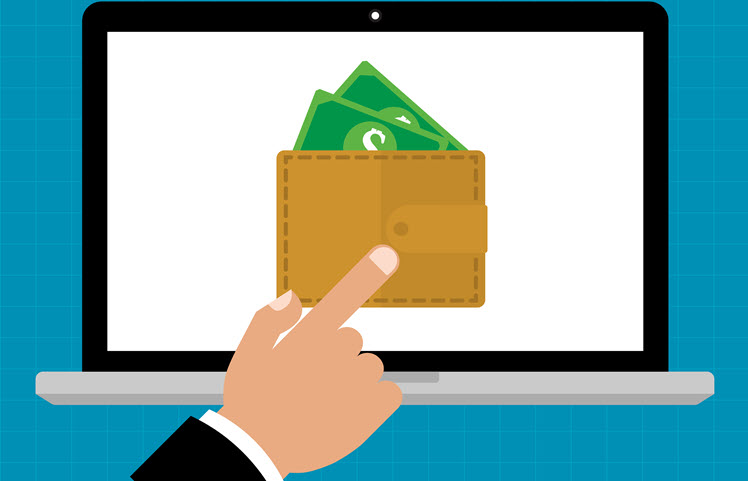Ecommerce is steadily growing, with a significantly higher growth rate than retail. To cater to this diverse and growing market, ecommerce businesses must meet buyers’ expectations.
Let’s dive deep in explaining the differences between e-wallets and credits cards.
|
E-Wallet |
Credit Card |
| What is it? |
Cloud-based software application used as a payment method for online and offline shopping. |
Plastic card for online or offline payments. The card draws funds from a predefined sum borrowed from the issuing bank. |
| Who is it for? |
Most e-wallets allow anyone over the age of 18 with an Internet connection to sign-up for their service in minutes. |
Users over 18 can apply for a credit card with a bank institution. The bank approves or rejects the request depending on the user’s financial situation. In the US, those aged 18-21 need to prove they have a steady income to receive a credit card. |
| Convenience |
Users pay by entering their PIN/password or verifying with an authentication method. |
Users need to enter their name, 16-digit credit card number, expiration date, 3-digit security code (CVV), and address. The process usually includes 2-factor authentication too. |
| Security |
Provides multi-layered security features. |
Provides multi-layered security features. |
| Costs and fees for consumers |
No cost to install and store money. Different transaction fees and taxes apply (depending on the e-wallet and payment methods used). |
Annual fee: $0-$100+
Different transaction fees and taxes apply (depending on the card).
|
| Frequency of use, globally (stats in 2019) |
43% |
53% |
What Is an E-Wallet (Digital Wallet)?
E-wallet or digital wallet is a software application for desktop, laptop, and mobile devices that stores personal and banking information. E-wallets allow users to link their preferred payment methods (e.g., credit, debit, prepaid card) to the account and make online payments.
Note: Electronic wallets are slightly different from mobile wallets. E-wallets are web-based applications, while mobile wallets are installed and used as mobile apps. The main difference between e-wallets and mobile wallets is that m-wallets are also used for offline shopping at retail locations that have the required technology for such payments.
How Do E-Wallets Work?
To create an e-wallet account, you provide your email address, personal details, and a specify a unique password. Payment methods are linked after signing up. You can store as many payment methods in a digital wallet as the wallet provider allows.
Every time you want to make a payment, you choose a preferred payment method (e.g., credit card, debit card, gift card, e-wallet balance) to complete the money transfer.
There are three ways to load money into your digital wallet:
- Link it with payment cards.
- Transfer cash to the e-wallet balance from an ATM machine or other locations with that option.
- Receive money from a third-party directly to the e-wallet.
Paying with e-wallets lets you skip the process of entering payment card information. Instead, you enter your username and password or PIN. Mobile wallets allow you to verify the payment with your fingertip or face recognition software.
When making payments via digital wallets, all information is tokenized and transmitted via a secure network. Tokenization is a process of encrypting real data with random strings of characters to protect data from hackers.
Pros of Using E-Wallets
People are increasingly using digital wallets, but some are still reluctant to adopt this payment method. Let’s look at the advantages and disadvantages of using e-wallets.
With e-wallets, there is less information to enter at checkout than with credit cards. The software lets you use numerous payment methods and leave all your physical payment cards at home.
Banking information in your e-wallet is digitally stored and encrypted during the payment process, making it difficult to steal payment information. Mobile wallets provide the same level of security as other secure payment methods, such as credit cards.
In Europe and China, digital wallets are more popular for online purchases than credit cards. With 75% of people worldwide shopping online at least once a month, e-wallet usage is constantly on the rise.
Extra rewards and discounts
You get the same rewards and points regardless of whether you use a credit card independently or via an e-wallet. Some e-wallet providers partner with credit card companies to offer more rewards and discounts.
Cons of Using E-Wallets
E-wallets have some downsides too.
E-wallets cannot function without Internet connection.
Hesitance towards new technology
What Is a Credit Card?
Credit cards are plastic cards issued by a bank. You need to be over 18 and with stable income to be approved a credit card.
A bank sets a certain limit that you can spend and a certain grace period to repay the sum without interest fees. Annual fees for owning a credit depend on the bank, but the average sum is $100. Some banks don’t charge annual fees.
How Do Credit Cards Work?
Credit cards are used both for online and offline payments. They can also be linked to e-wallets.
When paying online with a credit card, you need to provide several pieces of information (full name, 16-digit number on the credit card, card expiration date, 3-digit security code and address).
The payment information is sent via a secure network to the user’s credit card bank for approval. Once approved, the payment is verified.
Pros of Using Credit Cards
Credit cards are still the preferred method of online payment. Therefore, one of the most important steps of running an e-commerce business is to accept credit cards online.
Security and consumer protection
Credit card companies use numerous security measures to provide maximum security to consumers and merchants. They also protect users against fraud and unauthorized card use.
Credit cards enable you to pay for products and services when you need them and repay the amount later.
Better buying opportunities
Credit card history enables better conditions for certain purchases in the future. Credit card providers also offer numerous rewards and loyalty programs to users.
Cons of Using Credit Cards
More complicated to use than e-wallets
It takes longer to pay with a credit card because you need to enter full credit card information for each payment. There is the option of saving credit card details on a website for later use, but whether that is a safe option depends on the website in question.
Digital Wallet vs. Credit Card for Your Ecommerce – Final Verdict
Credit cards are still the most popular payment method on a global level, but e-wallets are quickly gaining new users. Both credit card and digital wallet providers use highly advanced security measures and offer a fast and convenient online shopping experience.
Therefore, to get new and retain old customers, ecommerce businesses need to provide both e-wallet and credit card payment methods on their online stores.




